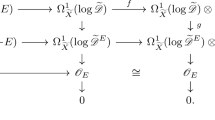Abstract
Let M and N be two representations of an extended Dynkin quiver such that the orbit \({\mathcal{O}}_N\) of N is contained in the orbit closure \(\overline{{\mathcal{O}}}_M\) and has codimension two. We show that the pointed variety \((\overline{{\mathcal{O}}}_M, N)\) is smoothly equivalent to a simple surface singularity of type A n , or to the cone over a rational normal curve.
Similar content being viewed by others
References
Bender J. and Bongartz K. (2003). Minimal singularities in orbit closures of matrix pencils. Linear Algebra Appl. 365: 13–24
Bongartz K. (1991). A geometric version of the Morita equivalence. J. Algebra 139: 159–171
Bongartz K. (1994). Minimal singularities for representations of Dynkin quivers. Comment. Math. Helv. 63: 575–611
Bongartz K. (1995). Degenerations for representations of tame quivers. Ann. Sci. École Norm. Sup. 28: 647–668
Bongartz K. (1996). On degenerations and extensions of finite dimensional modules. Adv. Math. 121: 245–287
Bongartz K. and Fritzsche T. (2003). On minimal disjoint degenerations for preprojective representations of quivers. Math. Comput. 72: 2013–2042
Hesselink W. (1976). Singularities in the nilpotent scheme of a classical group. Trans. Am. Math. Soc. 222: 1–32
Kraft H. and Procesi C. (1981). Minimal singularities in GL n . Invent. Math. 62: 503–515
Riedtmann Ch. (1986). Degenerations for representations of quivers with relations. Ann. Sci. École Norm. Sup. 4: 275–301
Ringel, C.M.: Tame algebras and integral quadratic forms. In: Lecture Notes in Mathematics, vol 1099. Springer, Heidelberg (1984)
Zwara G. (1998). Degenerations for representations of extendend Dynkin quivers. Comment Math. Helv. 73: 71–88
Zwara G. (2000). Degenerations of finite dimensional modules are given by extensions. Compos. Math. 121: 205–218
Zwara G. (2002). Smooth morphisms of module schemes. Proc. Lond. Math. Soc. 84: 539–558
Zwara G. (2002). Unibranch orbit closures in module varieties. Ann. Sci. École Norm. Sup. 35: 877–895
Zwara G. (2005). Regularity in codimension one of orbit closures in module varieties. J. Algebra 283: 821–848
Zwara G. (2005). Orbit closures for representations of Dynkin quivers are regular in codimension two. J. Math. Soc. Jpn 57: 859–880
Zwara G. (2006). Singularities of orbit closures in module varieties and cones over rational normal curves. J. Lond. Math. Soc. 74: 623–638
Author information
Authors and Affiliations
Corresponding author
Rights and permissions
About this article
Cite this article
Zwara, G. Codimension two singularities for representations of extended Dynkin quivers. manuscripta math. 123, 237–249 (2007). https://doi.org/10.1007/s00229-007-0093-3
Received:
Published:
Issue Date:
DOI: https://doi.org/10.1007/s00229-007-0093-3




